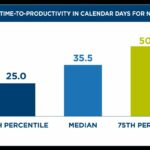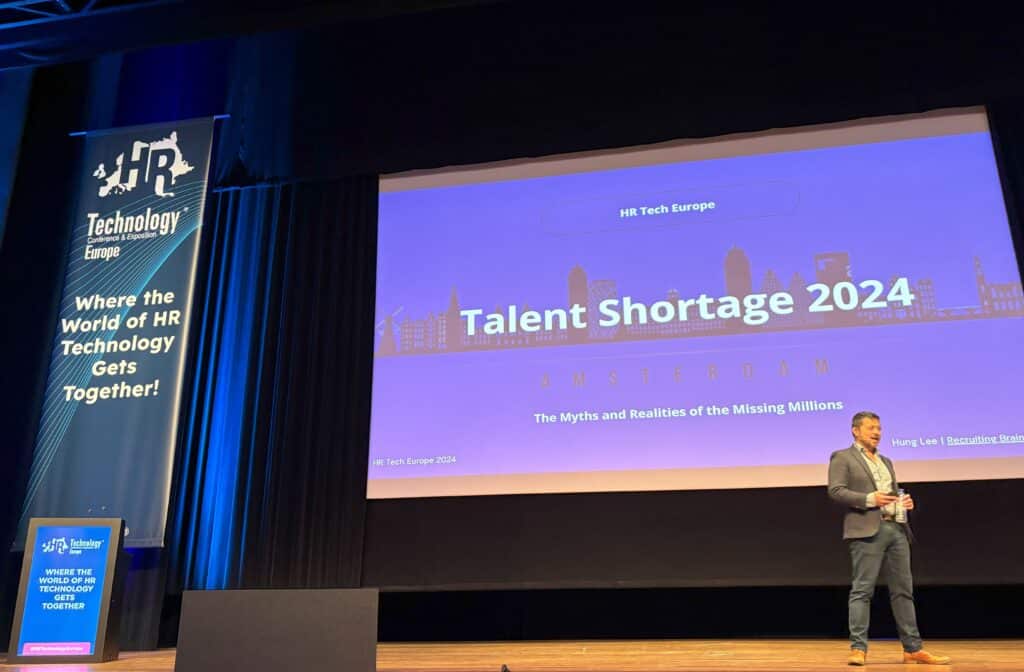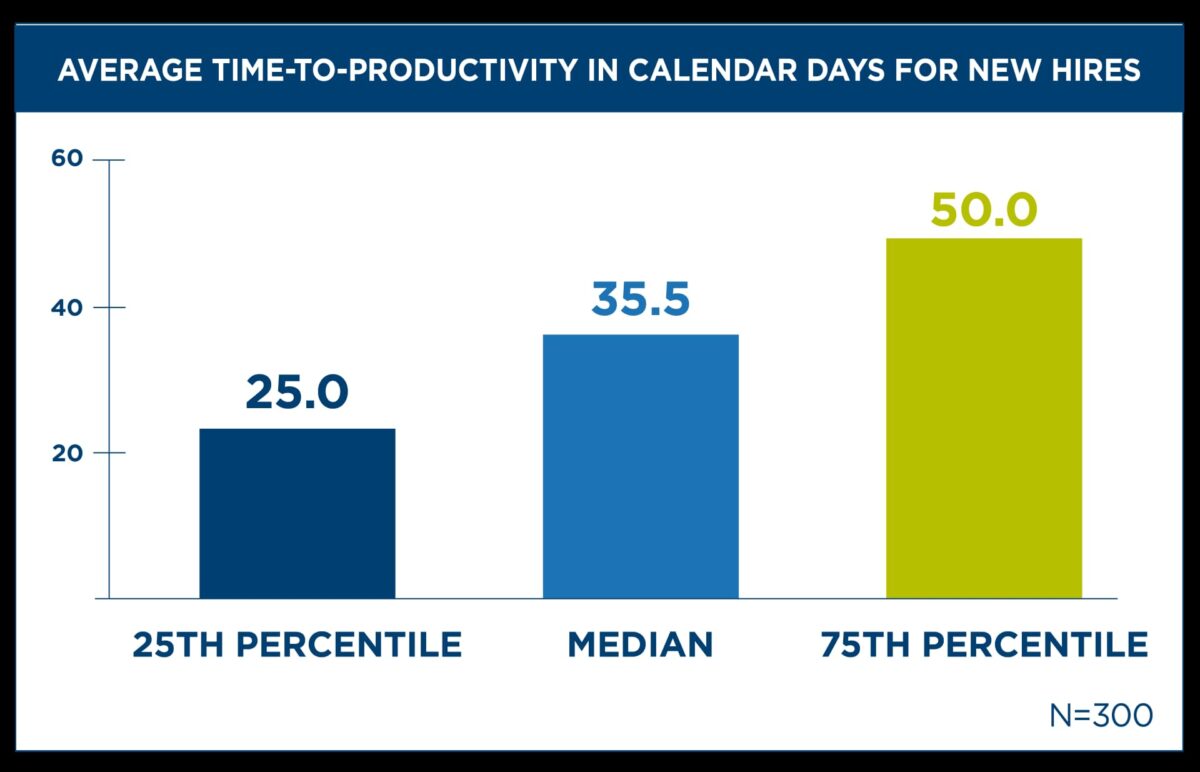Are millions of people missing from the modern workforce? Hung Lee says yes, there is a talent shortage, although not every employer is thinking ahead to fill the gaps likely to appear in their workforce.
Lee is the editor and curator at Recruiting Brainfood, one of the HR industry’s most respected sources covering talent acquisition. This seasoned recruitment industry professional delivered a highly anticipated keynote at the inaugural HR Technology Europe Conference in Amsterdam in early May.
A global talent shortage
In his session, Talent Shortage 2024: The Myths and Realities for the Missing Millions, Lee shared five theories explaining why employers worldwide are experiencing significant challenges finding the people they need to fill their workforce.
These reasons include a “demographic crisis” arising from an aging society; a mismatch of skills that people hold compared to those that employers need; “elite overproduction” of university graduates that has depleted the labor force for essential jobs; a geographical imbalance leaving open roles in places where the bulk of people don’t live; and an increase in mental and physical disabilities that are removing people entirely from the workforce.
“We can’t recruit the nurses, the teachers, the social workers, the drivers, the sanitation people, the security guards and the people who serve in the restaurant,” said Lee, asking the audience to consider the long-term impact of these vacancies.
The recruiting expert says that, on the worldwide stage, these conditions lead society to a problem zone where the working population is significantly shrinking or mismatched with needed jobs. “Immigration may no longer be an obvious pathway for us to replace the people that we need,” said Lee.
To address these societal matters, Lee provided five “broad buckets” of action employers can take to equip themselves to find the employees they need to meet business objectives.

Talent acquisition
This strategy involves optimizing every part of the recruitment funnel to compete better for the existing talent pool. In this approach, HR leaders leverage technology to improve assessments, conduct well-ordered interviews and improve scheduling to “get efficient at every single stage in the system,” said Lee. “All the companies presenting today in the [HR Technology Europe] Expo are optimizing for that.”
This approach doesn’t address the fundamental problems layered below the talent shortage, according to Lee. However, it can empower organizations to compete better for the willing and available talent already in the pipeline.
Talent diversity
In this environment, companies aim to expand the available labor pool by tapping into communities they haven’t previously interacted with. The challenge here is that jobs are typically designed for a specific demographic, with limited flexibility and a communication strategy built to attract a traditional worker.
To address this, said Lee, companies are starting to design fundamentally more flexible jobs, accommodating different types of people and working modes. “I think we could try to make some more efforts in designing jobs that are more inclusive, meaning we design jobs that aren’t exactly based on the template of this [classic] individual,” said Lee.
Talent circulation
This approach encourages employers to intentionally retain the people they’ve already hired rather than watching them leave for competitors. Traditional internal mobility programs often fail due to issues like limited discovery outlets, negative implications of applying and territoriality between HR and hiring managers, according to Lee.
Many internal applicants have fears: “What’s the confidentiality? Do the two managers talk to each other? Is there a situation where my current manager finds out that I’ve applied to this job and then it gives me problems later on?”
To minimize these conditions, some companies are experimenting with talent marketplaces, which match people to jobs based on their skills and preferences, making the process more secure and less consequential.
Lee says that successful internal talent marketplaces “disaggregate” personal aspects from the job description and look purely at the skills level. “And then from there, when we create a new job, we can figure out, OK, which one of these is best based on this person’s existing capabilities,” explained Lee.
Talent density
Talent density refers to increasing the skill quality per capita within the business. Lee describes the quintessential “A player” who succeeds in many aspects of their work. The idea is to “do more with less”—rather than hiring additional people. Here, the pressure is on HR to find, attract and bring on quality staff who can handle the same amount of work previously done by multiple people or a whole team.
This is achieved by building performance attributes into the assessment of candidates. “This is the ‘X 10 person,’ meaning that person is worth 10 others because they’re so skillful,” Lee explained.
Talent efficiency
This involves distributing projects or roles if the right workers can’t be found locally or even through a traditional hybrid arrangement. Lee describes situations when a company simply can’t find the people they need, instead dispersing the job to where the work can be done. He said remote work, which was made popular during the COVID pandemic, taught companies how to offshore and recruit further afield. But this was often for knowledge or white-collar workers.
Lee described how “telepresence” is pushing remote capabilities into frontline work, utilizing new technology to reduce geographic limits. This is leading to a movement of jobs with the potential to satisfy workers who typically immigrate to earn money and gain opportunities. “[Telepresence] is starting to appear in many, many places where telepresence, with the use of 5G and real-time communications, enables a lot of work to be performed by other people across the globe,” said Lee.
Wrapping up the presentation, Lee argued that HR leaders are in a position to positively influence the impacts of the “missing millions.” He says that human resource professionals should express that they understand the skills and composition of the business to bring these moves from theory into action.
He expects that business leaders will continue to turn to people operations, requesting expertise where needed despite the evidence of talent shortages. “That’s their demand for us,” said Lee. “So we need to respond to what that is.”
The post 5 strategies to handle global talent shortages appeared first on HR Executive.







